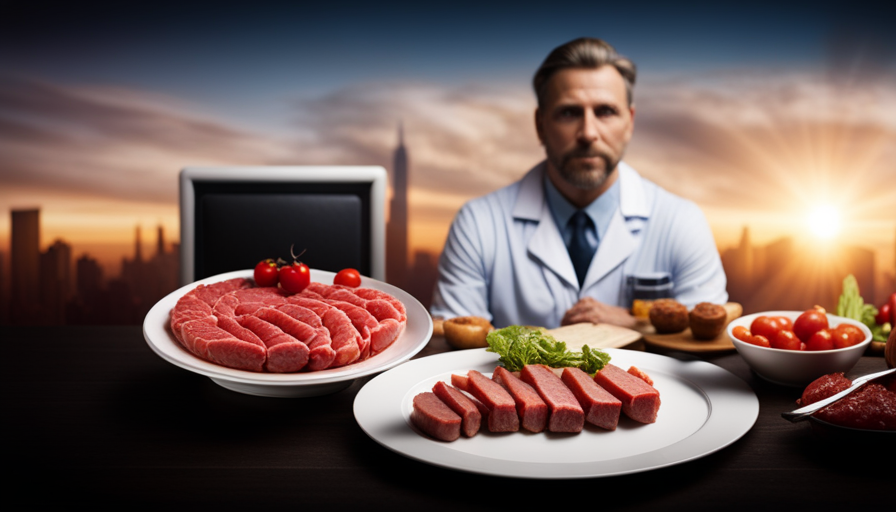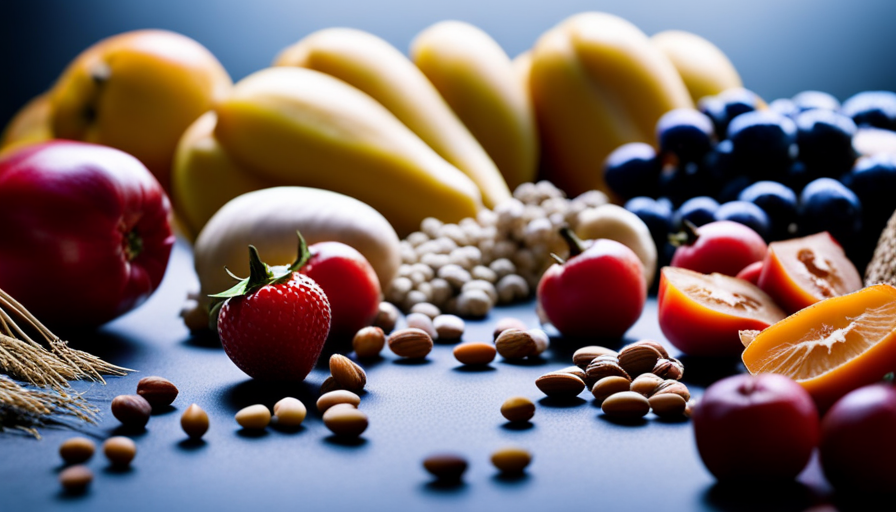Ever thought about experiencing the diet of our ancestors by eating food in its purest form? The concept of a raw food diet has been increasingly embraced by individuals looking to enhance their health and overall well-being with a simple and natural approach.
However, before jumping on the raw food bandwagon, it’s important to understand the potential risks and drawbacks that come with this dietary choice. While raw food enthusiasts claim numerous health benefits, such as increased energy and improved digestion, there are also potential pitfalls to consider.
In this article, we will explore the risks of a raw food diet, including nutrient deficiencies, foodborne illnesses, digestive issues, and more. By understanding these risks, you can make an informed decision about whether a raw food diet is right for you.
So, let’s dig deeper into the world of raw food and uncover the truth behind the hype.
Key Takeaways
- Nutrient deficiencies can occur due to reduced nutrient absorption in raw foods, particularly vitamins B12, iron, and calcium.
- Raw food diets can increase the risk of foodborne illnesses as harmful bacteria, viruses, and parasites can be present in uncooked foods.
- Raw food diets can lead to digestive issues and nutritional imbalances, as raw foods can be harder to digest compared to cooked foods.
- Raw food diets may result in caloric restriction and potential weight loss, but there is a risk of extreme weight loss and malnutrition if not properly managed.
Nutrient Deficiencies
You might think that a raw food diet is the healthiest choice, but did you know that it can put you at risk of nutrient deficiencies?
While raw fruits and vegetables are packed with essential nutrients, the human body may not be able to absorb them as effectively as when they’re cooked. Cooking can break down the cell walls of plants, making it easier for our bodies to access the nutrients within. Without this breakdown, some nutrients may remain locked away, leading to potential deficiencies.
Another concern with a raw food diet is the long-term sustainability of obtaining all necessary nutrients. It requires careful planning and knowledge to ensure that you’re getting a balanced diet. For example, a raw food diet may be low in certain vitamins like B12, iron, and calcium, which are primarily found in animal products. While plant-based alternatives exist, it can be challenging to consume enough of these nutrients solely from raw foods.
Transitioning to the next section about foodborne illnesses, it’s important to note that consuming raw foods can also put you at risk of infections.
Foodborne Illnesses
Foodborne illnesses can pose a significant threat when consuming uncooked ingredients. Raw food diets, which emphasize the consumption of uncooked and unprocessed foods, can increase the risk of foodborne illnesses due to the potential presence of harmful bacteria, viruses, and parasites. These pathogens can cause various symptoms, such as nausea, vomiting, diarrhea, and even more severe complications.
To minimize the risk of foodborne illnesses, it’s essential to prioritize food safety and practice proper hygiene when handling raw foods. This includes washing fruits and vegetables thoroughly, using separate cutting boards for raw meats and produce, and storing perishable items at appropriate temperatures. It’s also crucial to source ingredients from trusted suppliers and ensure they meet food safety standards.
While proponents of raw food diets argue that consuming uncooked foods preserves their natural enzymes and nutrients, it’s important to weigh these potential benefits against the increased risk of foodborne illnesses. By adopting proper hygiene practices and ensuring food safety, it’s possible to mitigate these risks and enjoy the potential health benefits of a raw food diet.
Transition to the next section about digestive issues: Alongside the risk of foodborne illnesses, raw food diets can also lead to digestive issues.
Digestive Issues
Transitioning to a raw food diet can result in potential digestive problems due to the increased intake of unprocessed and uncooked ingredients. While raw food enthusiasts argue that this diet provides more nutrients and enzymes, it can also lead to nutritional imbalances and long-term effects on the digestive system.
Raw food diets often lack certain nutrients that are essential for optimal health. For example, cooking increases the bioavailability of some nutrients, such as lycopene in tomatoes and beta-carotene in carrots. Without proper cooking, these nutrients may not be as readily absorbed by the body. Additionally, raw food diets tend to be low in certain vitamins and minerals, such as vitamin B12, iron, and calcium, which are primarily found in animal-based products.
Furthermore, the high fiber content of raw fruits and vegetables can cause digestive discomfort, especially when transitioning from a diet low in fiber. Increased fiber intake can lead to bloating, gas, and even diarrhea. While fiber is important for maintaining a healthy digestive system, sudden and excessive intake can overwhelm the digestive tract.
In the subsequent section about ‘increased fiber intake,’ we will explore how this aspect of raw food diets can impact digestive health without overwhelming the system.
Increased Fiber Intake
Increased fiber intake can have both positive and negative effects on the digestive system. On one hand, it can promote regular bowel movements and prevent constipation. However, it can also lead to digestive discomfort or diarrhea, especially if the increase in fiber intake is sudden and not accompanied by adequate hydration.
Additionally, for individuals with certain digestive disorders or conditions, such as irritable bowel syndrome or Crohn’s disease, a high-fiber diet may increase the risk of nutrient malabsorption and worsen symptoms. It’s important to monitor fiber intake and adjust accordingly to avoid any negative impact on blood sugar levels or digestive health.
Potential for digestive discomfort or diarrhea
Although a raw food diet may offer numerous health benefits, there’s a chance of experiencing tummy troubles, like bloating or loose stools. This is because raw foods are harder to digest compared to cooked foods.
The high fiber content in raw fruits and vegetables can lead to increased bowel movements, potentially causing diarrhea. Additionally, raw foods can be more difficult for the body to break down, leading to digestive discomfort. It’s important to note that diarrhea can also increase the risk of dehydration, as it can cause excessive fluid loss from the body. Therefore, it’s crucial to stay hydrated when following a raw food diet to prevent any potential complications.
Moving forward, another risk to consider is the potential for nutrient malabsorption.
Risk of nutrient malabsorption
While digestive discomfort and diarrhea are potential risks of a raw food diet, it’s important to also consider the risk of nutrient malabsorption. Raw foods can be more difficult to digest and may not provide the same level of nutrient absorption as cooked foods.
This is because some nutrients, such as certain vitamins and minerals, are more easily absorbed when they’re cooked. Additionally, certain raw foods contain compounds that can inhibit the absorption of nutrients or require specific enzymes for proper digestion. Therefore, individuals on a raw food diet may face challenges in obtaining all the necessary nutrients their body needs for optimal health.
It’s crucial to carefully plan and diversify food choices to ensure adequate nutrient absorption.
Moving forward, let’s explore the impact of a raw food diet on blood sugar levels.
Impact on blood sugar levels
Maintaining stable blood sugar levels can be a challenge when following a raw food lifestyle. Since raw foods are often low in carbohydrates and high in fiber, they can cause a slower release of glucose into the bloodstream, leading to more stable blood sugar levels. However, this can also result in a lower overall intake of carbohydrates, which may lead to a decreased insulin response. This can be particularly problematic for individuals with diabetes or pre-diabetes who rely on insulin to regulate their blood sugar levels. It is important for individuals following a raw food diet to closely monitor their blood sugar levels and work with a healthcare professional to ensure proper blood sugar management.
| Pros | Cons |
|---|---|
| High in fiber | Low in carbohydrates |
| Slow release of glucose | Decreased insulin response |
| Stable blood sugar levels | Potential for hypoglycemia |
Moving on to the next topic, the potential for weight loss is a common motivation for individuals following a raw food diet.
Potential for Weight Loss
When it comes to potential weight loss on a raw food diet, one key point to consider is caloric restriction. By consuming mainly raw fruits, vegetables, and nuts, individuals may naturally consume fewer calories, which can lead to weight loss.
However, it is important to be cautious of the risk of extreme weight loss or malnutrition, as a raw food diet may not provide all the essential nutrients our bodies need. Additionally, meeting energy needs can be a challenge on a raw food diet, as it may require careful planning and consideration to ensure adequate intake of calories.
Caloric restriction from raw food diet
Consuming a raw food diet can lead to a decrease in calorie intake, potentially resulting in weight loss. When following a raw food diet, individuals often consume fewer calories compared to a diet that includes cooked foods. This is because raw foods are generally less calorie-dense and more filling due to their high water and fiber content. Additionally, the emphasis on whole, unprocessed foods in a raw food diet can lead to a better caloric intake and nutritional balance. However, it is important to note that caloric restriction from a raw food diet can also pose risks if not properly managed. Extreme caloric restriction can lead to malnutrition and other health complications. Therefore, it is crucial to ensure that a raw food diet is well-planned and includes a variety of nutrient-dense foods to avoid the risk of extreme weight loss or malnutrition.
Risk of extreme weight loss or malnutrition
It’s crucial to ensure that a properly balanced raw food eating plan includes a variety of nutrient-dense options to avoid the potential for extreme weight loss or malnutrition. While raw food diets can be low in calories, it’s important to consume enough energy to maintain a healthy weight and meet nutritional needs.
Extreme weight loss can lead to a range of health issues, including muscle wasting, weakened immune function, and hormonal imbalances. Additionally, malnutrition can occur when the body does not receive adequate amounts of essential nutrients like protein, vitamins, and minerals. This can result in fatigue, weakened bones, impaired cognitive function, and compromised overall health.
Therefore, it’s essential to carefully plan a raw food diet to ensure it provides sufficient calories and a balanced array of nutrients. Transitioning into the subsequent section about the ‘difficulty in meeting energy needs’, it’s important to address the challenges of maintaining adequate energy levels on a raw food diet.
Difficulty in meeting energy needs
To ensure you have enough energy to thrive, meeting your body’s needs can be a challenge on a diet consisting mainly of uncooked, plant-based meals. While raw food diets can provide a variety of nutrients, it can be difficult to consume enough calories to meet your energy requirements. This is because raw foods tend to be less calorie-dense compared to cooked foods. Additionally, nutritional imbalances can arise if you don’t carefully plan your meals. For example, it may be challenging to obtain sufficient protein, iron, and vitamin B12 on a raw food diet. To help visualize these challenges, refer to the table below:
| Challenge | Solution |
|---|---|
| Low calorie intake | Include more calorie-dense foods such as avocados, nuts, and seeds |
| Protein deficiency | Incorporate plant-based protein sources like legumes and quinoa |
| Iron deficiency | Consume iron-rich foods like spinach, lentils, and tofu |
| Vitamin B12 deficiency | Consider supplementation or consuming fortified foods |
Considering these challenges, it’s important to be mindful of meeting your energy needs and addressing potential nutritional imbalances on a raw food diet. Moving forward, it’s crucial to also consider dental health concerns.
Dental Health Concerns
Your dental health may be at risk on a raw food diet, as the lack of cooked foods can lead to increased plaque buildup and potential tooth decay. Oral hygiene is crucial to maintaining healthy teeth and gums, and cooked foods play a significant role in this.
When we cook our food, it softens and becomes easier to chew, reducing the strain on our teeth. Raw foods, on the other hand, can be tough and require more effort to chew. This constant stress on the teeth can lead to enamel erosion and even tooth fractures.
Additionally, raw food diets often include a high intake of fruits, which contain natural sugars. These sugars can stick to the teeth and provide a breeding ground for bacteria, leading to plaque formation and eventually tooth decay. Without proper oral hygiene practices, such as regular brushing and flossing, the risk of dental issues increases significantly.
To maintain dental health while following a raw food diet, it is essential to pay close attention to oral hygiene. Regular brushing and flossing, along with regular dental check-ups, can help prevent plaque buildup and identify any potential issues early on. Moreover, incorporating some cooked foods into the diet can help reduce the strain on the teeth and provide a more balanced approach to oral health.
Moving on to food safety and handling, it is important to ensure that the raw foods consumed are safe and free from contamination.
Food Safety and Handling
Dental health concerns are not the only potential risks associated with a raw food diet. Another important aspect to consider is food safety and handling.
It is crucial to practice proper food safety practices when preparing raw foods to minimize the risk of foodborne illnesses. Raw food, especially when it comes from animal sources, can harbor harmful bacteria such as Salmonella, E. coli, and Campylobacter. These bacteria can cause severe gastrointestinal symptoms and can be particularly dangerous for individuals with weakened immune systems, such as the elderly, young children, and pregnant women.
To reduce the risk of foodborne illnesses, it is essential to handle raw food properly. This includes washing fruits and vegetables thoroughly, using separate cutting boards and utensils for raw meats and produce, and storing perishable raw foods at the correct temperature.
Additionally, it is important to source raw foods from reputable and trustworthy suppliers to ensure their safety and quality. By following these food safety practices and being cautious about raw food preparation, you can minimize the potential risks associated with a raw food diet.
Transitioning to the subsequent section about sustainability and environmental impact, it is also important to consider the broader implications of the raw food movement on our planet.
Sustainability and Environmental Impact
The sustainability and environmental impact of a raw food diet are important considerations to evaluate. Firstly, the resource-intensive nature of this diet should be taken into account, as it often requires a significant amount of energy and resources to produce and transport raw foods.
Secondly, there is a potential for increased food waste with a raw food diet, as it may be challenging to consume all the perishable foods before they spoil.
Lastly, the impact on land and water use should be considered, as the production of raw foods may require larger amounts of land and water compared to other types of diets.
Resource-intensive nature of raw food diet
If you’re considering a raw food diet, be aware that it can be challenging to sustain due to the resource-intensive nature of sourcing and preparing raw ingredients. Raw food diets often require a significant amount of fruits, vegetables, nuts, and seeds, which can be expensive and time-consuming to obtain. Additionally, the production of raw food ingredients often requires large amounts of water, land, and energy. To illustrate this, consider the following table:
| Resource | Raw Food Diet | Conventional Diet |
|---|---|---|
| Water | High | Moderate |
| Land | High | Moderate |
| Energy | High | Moderate |
As the table shows, raw food diets tend to be more resource-intensive compared to conventional diets. This can have negative implications for resource efficiency and environmental sustainability. Moving forward, it is important to acknowledge the potential for increased food waste in the context of a raw food diet.
Potential for increased food waste
By embracing a raw food lifestyle, I open the door to a world of culinary creativity and endless possibilities, all while being mindful of minimizing food waste.
One of the potential risks of a raw food diet is the potential for increased food waste. When consuming a raw food diet, there’s a higher likelihood of discarding parts of fruits and vegetables that aren’t typically eaten in their raw form, such as peels, stems, and seeds. This can result in a significant amount of food waste that could’ve otherwise been utilized.
Food waste reduction is essential for minimizing the environmental impact of our food choices.
In the subsequent section about the impact on land and water use, we’ll explore how a raw food diet affects these vital resources.
Impact on land and water use
Embracing a raw food lifestyle can have a significant impact on how we utilize and conserve our precious land and water resources. By consuming raw foods, we reduce the need for large-scale agricultural practices that often contribute to deforestation and land degradation. Additionally, raw food diets typically emphasize plant-based foods, which require less water compared to the production of animal-based products. This focus on land and water conservation is crucial in mitigating the environmental impact of our food choices.
To illustrate the impact of raw food diets on land and water use, consider the following table:
| Land Conservation | Water Conservation |
|---|---|
| Reduced need for large-scale farming | Lower water consumption |
| Decreased deforestation and land degradation | Reduced water pollution |
| Preservation of natural habitats | Less irrigation required |
| Enhanced soil health and biodiversity | Decreased reliance on irrigation |
With these considerations in mind, it is evident that a raw food diet can contribute to the overall conservation of land and water resources. However, it is important to acknowledge and address the social and practical challenges that may arise when adopting this lifestyle.
Social and Practical Challenges
Navigating social situations and everyday practicalities can pose challenges when following a raw food diet, but don’t worry – you’ve got this! While the raw food diet offers numerous health benefits, it can be difficult to maintain in certain social settings. Eating out with friends or attending social events may require some extra planning and preparation.
Many restaurants may not have extensive raw food options, so it’s important to research and choose venues that can accommodate your dietary needs. Communicating your preferences to friends and family can also help ensure they understand and support your choices.
In addition to social challenges, there are practical considerations to keep in mind. Raw food diets often require more time in the kitchen for meal preparation and planning. It can be challenging to find a variety of fresh and organic ingredients year-round, especially in certain geographic locations or during certain seasons. Storing and transporting raw food can also be a challenge, as it often requires refrigeration and careful handling to maintain freshness.
Transitioning to the next section about individual variations and personalized needs, it’s important to remember that everyone’s dietary requirements are unique. Understanding your own body’s needs and limitations is essential when following a raw food diet.
Individual Variations and Personalized Needs
Understanding your own unique body and its specific needs is crucial when tailoring a raw food lifestyle to suit your personal preferences. Each person’s body is different, and what works for one individual may not work for another. When it comes to following a raw food diet, it’s important to consider your individual preferences and dietary restrictions.
Here are three key points to keep in mind:
-
Personalized approach: Adopting a raw food diet requires personalization. Some people may thrive on a high-fruit diet, while others may prefer a more balanced approach with a mix of fruits, vegetables, nuts, and seeds. It’s essential to experiment and find what works best for your body.
-
Nutritional needs: While a raw food diet can be nutrient-dense, it’s important to ensure you’re meeting your nutritional needs. Certain individuals may require additional supplementation or modifications to ensure they’re getting enough essential nutrients such as vitamin B12, iron, and omega-3 fatty acids.
-
Dietary restrictions: If you have specific dietary restrictions, such as allergies or intolerances, it’s crucial to carefully plan your raw food diet to avoid any potential issues. For example, if you have a nut allergy, you’ll need to find alternative sources of protein and healthy fats.
By understanding your individual preferences and dietary restrictions, you can create a raw food diet that’s tailored to your unique needs and supports your overall health and well-being.
Frequently Asked Questions
Can a raw food diet provide all the necessary nutrients for optimal health?
Sure, a raw food diet can definitely provide all the necessary nutrients for optimal health. It’s absolutely amazing how this diet challenges you to find creative ways to eat raw food, while also reaping the benefits of increased energy and improved digestion.
By incorporating a variety of fruits, vegetables, nuts, and seeds, you can easily meet your nutritional needs. However, it’s important to be aware of the risks associated with this diet, such as potential nutrient deficiencies and foodborne illnesses.
Potential food safety concerns and the impact on gut health are important considerations when following a raw food diet. Raw foods, such as meat, eggs, and unpasteurized dairy, can harbor harmful bacteria like Salmonella and E. coli. These bacteria can cause foodborne illnesses and lead to digestive issues.
Additionally, cooking food can help break down certain components, making it easier for our bodies to absorb nutrients. Therefore, it’s crucial to handle and prepare raw foods properly to minimize these risks and ensure optimal gut health.
What are the potential long-term consequences of nutrient deficiencies on a raw food diet?
Long-term health on a raw food diet? Oh boy, where do I begin?
Well, let’s talk about nutrient deficiencies. You see, when you only eat raw food, you’re missing out on essential nutrients like B12, iron, and omega-3 fatty acids. And guess what? These deficiencies can lead to serious health problems like anemia, weakened immune system, and even cognitive issues.
So, if you’re planning on going raw, make sure you supplement properly to avoid these long-term consequences.
Raw food diet risks can lead to potential health problems. Consuming raw food increases the risk of foodborne illnesses caused by harmful bacteria, viruses, and parasites. These pathogens can cause severe gastrointestinal issues, such as diarrhea and vomiting.
Additionally, a raw food diet may lack essential nutrients like vitamin B12, iron, and calcium, which can lead to deficiencies and long-term health consequences.
It’s crucial to carefully consider the potential risks and consult with a healthcare professional before adopting a raw food diet.
Is it possible to prevent foodborne illnesses on a raw food diet?
To prevent foodborne illnesses on a raw food diet, it’s crucial to follow proper food handling and storage practices. This includes preventing cross-contamination by using separate cutting boards for raw and cooked foods. It’s also important to wash hands thoroughly before and after handling food and store perishable items at the right temperature.
Additionally, it’s important to choose high-quality ingredients and wash fruits and vegetables thoroughly before consuming them. By implementing these practices, the risk of foodborne illnesses can be significantly reduced.
What Nutritional Deficiencies Are Associated with a Raw Food Diet?
A raw food diet may put you at a higher risk for deficiencies in vitamin B12, iron, calcium, and omega-3 fatty acids. Since these nutrients are typically found in animal products or fortified foods, it’s important to carefully plan a raw diet to prevent potential deficiencies.
Conclusion
In conclusion, the risks of a raw food diet should not be overlooked. While it may seem like a trendy and healthy way to eat, it can lead to nutrient deficiencies, foodborne illnesses, and digestive issues.
Interestingly, a study conducted by the Centers for Disease Control and Prevention found that raw food diets were responsible for 7% of reported foodborne illness outbreaks. This statistic highlights the importance of carefully considering the potential risks before embarking on a raw food diet.
It’s crucial to prioritize food safety, nutrition, and overall well-being.










